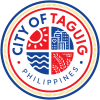Bagumbayan, Taguig
- View a machine-translated version of the Tagalog article.
- Machine translation, like DeepL or Google Translate, is a useful starting point for translations, but translators must revise errors as necessary and confirm that the translation is accurate, rather than simply copy-pasting machine-translated text into the English Wikipedia.
- Do not translate text that appears unreliable or low-quality. If possible, verify the text with references provided in the foreign-language article.
- You must provide copyright attribution in the edit summary accompanying your translation by providing an interlanguage link to the source of your translation. A model attribution edit summary is
Content in this edit is translated from the existing Tagalog Wikipedia article at [[:tl:Bagumbayan, Taguig]]; see its history for attribution. - You may also add the template
{{Translated|tl|Bagumbayan, Taguig}}to the talk page. - For more guidance, see Wikipedia:Translation.


Bagumbayan is one of the 38 barangays of Taguig, Metro Manila in the Philippines. It is also one of the nine original Barrio of Taguig.[2][3]
Etymology
The barangay acquired its original name, Bagong Bayan, which means "new town" in Tagalog, upon its establishment. It was later shortened to its present name, Bagumbayan.
History
During the Spanish Colonial Era, what is now Bagumbayan was filled with forests. No one was brave enough to settle here except for the Tanyag and Garcia families, both of which came from the village of Tipas. Once they settled there, the Spanish Government established it as a barangay of Taguig. Because it was recently founded, it was named Bagong Bayan and later shortened to Bagumbayan. Its first lumang bayan (barangay head) was Cererina San Juan, and the primary jobs of the people then were fishing and farming. The next people to occupy the position of barangay head before the American Colonial Period were Tandoy Sta. Teresa, Lelay Sta. Teresa, and Cepruto Marcelo.
During the time of the Americans and the Japanese in the Philippines, Laureano Garcia became the barangay's head and was followed by Victor Padsisihan, Segundo Magundayao, Arturo Tanyag, Francisco Javier, and Nicanor Garcia. Though it was the latest town that was founded then, the citizens of Taguig trusted the following people to be its councilors: Elino Cruz, Benito Garcia, Cerilo P. Santos, Arsenio Javier, Jose Aquino, Francisco dela Rosa, Francisco Tortosa, Claudio Marcelo and Rufino Dacumos.
In 1958, the barangay was nicknamed "Sleeping Town" because the livelihood of its people advanced slowly. However, later in 1959, their livelihood was stimulated because the value of the land in the area that was normally exposed or used for agriculture suddenly increased. Because of this, the government ordered the construction of what was then called the South Superhighway, leading to an increase in land purchases by corporations. From there, Bagumbayan developed into the barangay it is now.[4]
Geography
Bagumbayan is bounded on the north by Lower Bicutan and Central Bicutan, to the east by Laguna de Bay, to the south by Bagumbayan River and Sucat in Muntinlupa, and on the west by the Philippine National Railways tracks and barangays North Daang Hari, Tanyag, and South Daang Hari.
References
- ^ "2020 Census of Population and Housing (2020 CPH) Population Counts Declared Official by the President | Philippine Statistics Authority". psa.gov.ph. Retrieved July 12, 2021.
- ^ Bravo, Felipe (1851). Diccionario geografico, estadistico, historico de las islas Filipinas... (in Spanish). Imprenta de José C. de la Peña.
- ^ Diccionario Geografico Estadistico Historico Islas Filipinas, Manuel Buzeta, Felipe Bravo, Rector Del Colegio De Valladolid, Madrid 1850, page 326
- ^ A gift of faith, 400 years. Quadricentennial (1587-1987) St. Anne Parish Tagig, Metro Manila; commemorative book page 61, circa 1987.
- v
- t
- e
- Historical markers
- Mayor
- People
- Public education
- Skyscrapers
- Tourism
- Transportation

- Bagumbayan
- Bambang
- Calzada
- Cembo
- Central Bicutan
- Central Signal Village
- Comembo
- East Rembo
- Fort Bonifacio
- Hagonoy
- Ibayo-Tipas
- Katuparan
- Ligid-Tipas
- Lower Bicutan
- Maharlika Village
- Napindan
- New Lower Bicutan
- North Daang Hari
- North Signal Village
- Palingon Tipas
- Pembo
- Pinagsama
- Pitogo
- Post Proper Northside
- Post Proper Southside
- Rizal
- San Miguel
- Santa Ana
- South Cembo
- South Daang Hari
- South Signal Village
- Tanyag
- Tuktukan
- Ususan
- Upper Bicutan
- Wawa
- Western Bicutan
- West Rembo
| Pateros–Taguig |
|
|---|---|
| Taguig |
|
| Makati |
|
This article about a location in Metropolitan Manila (NCR) is a stub. You can help Wikipedia by expanding it. |
- v
- t
- e













